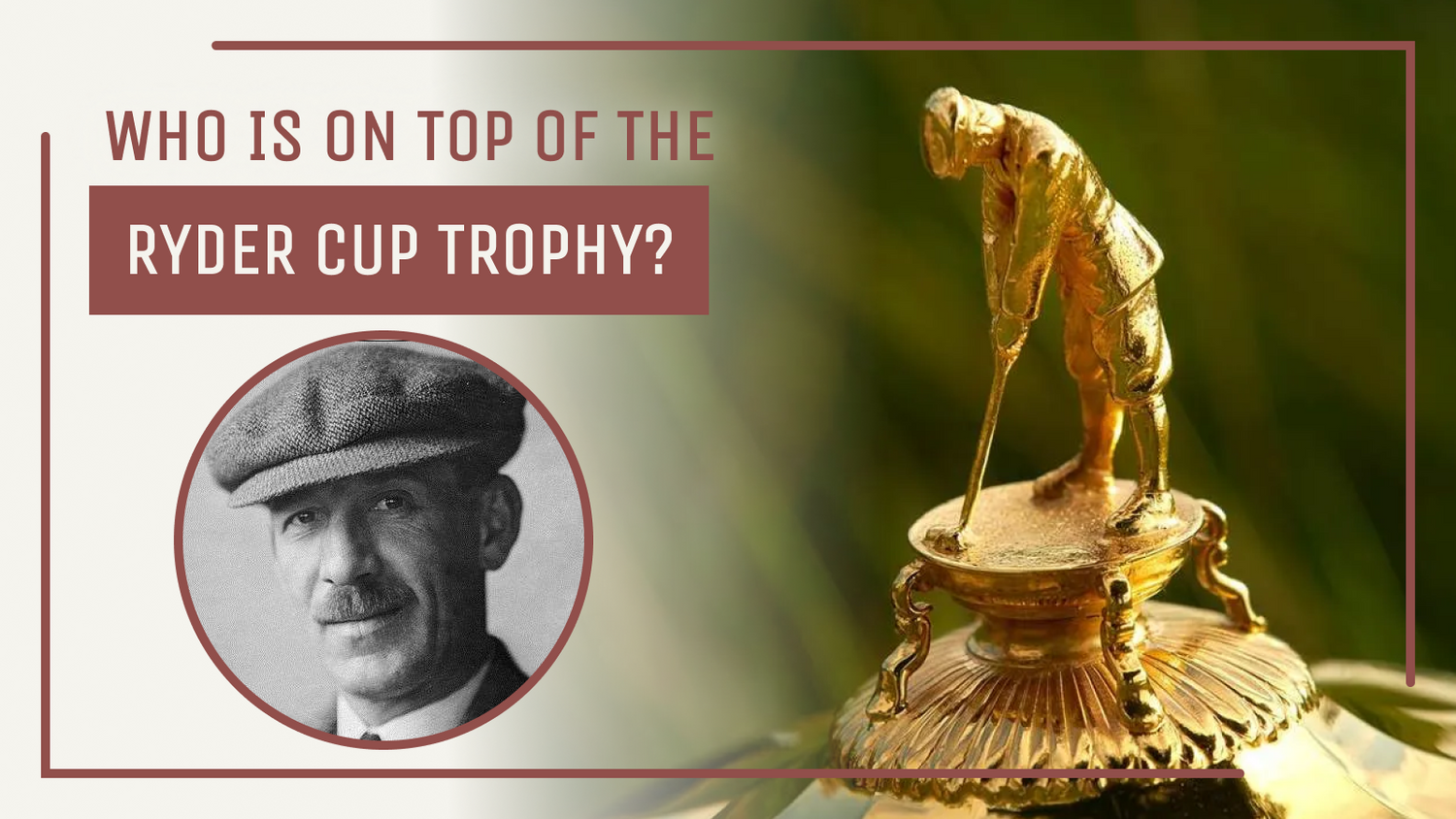As golf enthusiasts gaze upon the gleaming Ryder Cup trophy, one question often crosses their minds: Who is the player immortalized on top of this coveted prize?
The short answer is Abe Mitchell, a name etched in the annals of golfing history. But who was this enigmatic figure, and how did he come to occupy such a prestigious place? Read more as we delve into the fascinating journey of Abe Mitchell, from humble beginnings to the man immortalized on the Ryder Cup.
From Rags to Riches: The Inspiring Journey of Abe Mitchell
Abe Mitchell's journey certainly had a humble beginning.
Born as the illegitimate son of Mary in a Victorian-era East Grinstead workhouse, his early life faced considerable adversity. Yet, this remarkable individual would ascend to become one of the highest-earning athletes of his time, ultimately achieving the distinction of being the enduring symbol of the Ryder Cup.
The story of the 'Cantelupe Crack' is nothing short of a classic rags-to-riches tale.
In his youth, Abe displayed resourcefulness and determination by crafting his own golf clubs from branches he cut from trees and using balls discovered in the thickets. However, his initial success in 1910 was met with skepticism, as he was often labeled an "artisan" golfer, a perceived "workman" encroaching on the exclusive domain of gentlemen.
Abe's path to golfing glory faced a significant interruption when he served on the front lines during World War One. The harrowing experiences of the war left him grappling with anxiety, which would later affect his performance on the golf course. Regrettably, despite his talent and dedication, Abe Mitchell never secured a major championship victory, ultimately earning the title of the
"greatest player to never win The Open,"
a designation bestowed upon him by the esteemed five-time champion, JH Taylor.

The Birth of Cantelupe Club and Abe's Golfing Roots
Abe Mitchell's golfing journey commenced at the tender age of three, as he wandered onto the verdant fairways of Royal Ashdown Forest. This historic golf course had itself only been established a year after Mitchell's birth in January 1887.
The course, carefully shaped on common grounds owned by the seventh Earl De La Warr, on the outskirts of Forest Row in East Sussex, wasn't without its challenges. It attracted pedestrians who were unwilling to relinquish their right of way, and the local smallholders occasionally caused damage to the greens.
In an effort to find common ground and harmony, the more affluent members of the golf club made the unanimous decision to engage with these commoners. This initiative resulted in the establishment of the artisan Cantelupe Club in 1892, bearing the name of Viscount Cantelupe, the son of the Earl.
Today, the Cantelupe Club stands as the oldest surviving artisan section in England. Max Pearson, the current Cantelupe captain, says, "It was a club designed for the local residents, requiring them to reside within a five-mile radius of the village, though in contemporary terms, it lies within four miles of the church spire."
The Cantelupe Club's recruitment of artisans as its initial greenstaff was a mutually beneficial arrangement, offering them the privilege of playing golf for free.
This arrangement proved to be particularly advantageous for Abe and his family, whose modest beginnings might have otherwise barred them from access to their local golf course. Abe was just one of four brothers and had seven cousins and uncles who initially joined the Cantelupe Club. Remarkably, all of them would eventually pursue careers as greenkeepers or golf professionals.
Colin Strachan, a member of Royal Ashdown Forest since 1978 and the author of the club's rich history in his book "Fair Ways in Ashdown Forest," attests to the formidable talent of the Mitchell clan. He notes,
"They could assemble a team of Mitchells and effortlessly outplay Oxford or Cambridge University teams."
Rise to Golfing Prominence & Challenging Golf's Class Divide
Mitchell's passion for golf was evident from a young age. By the tender age of eight, he was resourcefully crafting his own golf clubs from branches harvested from beech trees and using balls he found on the course. Remarkably, by the age of 12, he was not only playing alongside adults but also beating them.
In 1910, Abe's golfing prowess reached the point where he received commendation to join the England team facing Scotland. The recommendation came from none other than AG Hutchinson, a golfer whom Mitchell had triumphed over four times in the annual matches that pitted the artisans against the club's members.
However, Mitchell's inclusion in the team came at a cost to Hutchinson, who lost his spot. Golf Illustrated, a prominent publication of the time, heralded Mitchell's selection as "the advent of the working man in the ancient and honorable profession of gardening." In a somewhat condescending tone, the magazine suggested that the match featured
"the cream of gentleman golfers, and then there's Abe Mitchell."
Undaunted by the skepticism surrounding his abilities, Mitchell silenced his critics in the same year by securing victory in the prestigious Golf Illustrated Gold Vase at Sunningdale. He repeated this triumph in 1913 at Walton Heath, solidifying his standing in the world of golf.

Golf Illustrated, while begrudgingly acknowledging Mitchell's accomplishments, couldn't resist a touch of derision. They described him as "a gardener hailing from a working man's golf society with playing rights at Royal Ashdown," even going so far as to admit that they had "never seen a workman play before."
This led Mitchell to reflect on the class distinctions within English golf, remarking,
"Golf is a game of classes in England, and it is my firm belief that artisans are not particularly welcome."
Abe’s Battlefield: From the Course to the Front Line
In June 1914, Mitchell achieved one of his highest Open Championship finishes, securing a tie for fourth place at Prestwick. This event also marked the legendary Harry Vardon's record-sixth triumph in golf's oldest major championship.
However, the onset of World War One just a month later cruelly interrupted Mitchell's burgeoning career. During the war, he spent a significant portion of his time on the front lines in northern France, tasked with pulling horses that in turn hauled immense artillery through treacherous mud. Golf courses, including Royal Ashdown, were transformed into training grounds for soldiers, with remnants of those times still visible at the club.
Colin Strachan, a chronicler of the club's history, recalls, "Training for soldiers typically lasted a fortnight, after which they would assemble for church services on Sundays before being loaded into cattle trucks. The entire village of Forest Row would gather to watch them depart down the hill from the club. Abe Mitchell, blessed with exceptional strength, emerged as one of the fortunate individuals to survive the war."
The Open Championship and the Lucrative Tour of 1922
Abe Mitchell had earned a reputation as one of the game's longest and most accurate drivers. When The Open Championship returned to Royal Cinque Ports in Kent in 1920, Mitchell made a resounding statement by surging into a commanding six-shot lead after the first two rounds on June 30.
However, his fortunes took a downturn during the morning's third round, as he struggled and posted an 84, causing his substantial lead to dwindle. Ultimately, he finished in fourth place, trailing Scotland's George Duncan by a margin of four strokes.
Yet, Mitchell's friendship with George Duncan would turn out to be quite lucrative. In 1922, the duo embarked on a whirlwind tour of the United States and Canada, a journey that would prove to be financially rewarding. They each earned a substantial sum of at least $25,000, an amount equivalent to approximately £370,000 in today's currency.
While precise details about the duration of their trip are somewhat sketchy, Colin Strachan, an authority on the club's history, believes it would have spanned roughly three months. He notes,
"They were competing for enormous sums of money,"
highlighting that they played two rounds of golf each day and completed a staggering 84 rounds. Their journey took them as far north as Winnipeg in central Canada and as far south as Florida, with stops along the way in locations such as Kansas, Milwaukee, and New York.
Their competitive prowess shone brightly as well, as they won an impressive 51 of the matches, only occasionally falling to golfing greats like Walter Hagen, who had secured 11 major titles, and the emerging talent Gene Sarazen, who would later capture seven majors.
When Abe Met Sam
Mitchell and Duncan repeated their American sojourn in 1925, this time with the backing of Walter Hagen (pictured below with Abe), who once again ensured they each received $25,000. They further augmented their earnings by winning bets on their matches, solidifying their reputation as formidable competitors on both sides of the Atlantic.

During this period, Abe Mitchell crossed paths with Samuel Ryder, a wealthy seed merchant who would later become the visionary behind the transatlantic golf tournament that now proudly bears his name.
Ryder, who took up golf at the age of 50 upon receiving medical advice advocating more fresh air and exercise, resided in St Albans, just north of London. He became a member of Verulam Golf Club in the city and actively sponsored golf tournaments. It was through these endeavors that he came to know and employ Abe Mitchell as his personal coach. Ryder offered Mitchell an annual salary of £500 and covered his expenses for participation in various tournaments.
From Ryder Cup Triumphs to Trophy Immortality
Abe Mitchell was due to compete in the inaugural Ryder Cup in 1927, scheduled to take place at Worcester Country Club in Massachusetts. However, historical reports suggested that he was unable to make the journey due to an episode of appendicitis. Colin Strachan, with his deep knowledge of Mitchell's history, disputes this claim, proposing an alternative theory. He posits,
"I believe it was a manifestation of his anxiety that prevented him from traveling."
Subsequently, Mitchell participated in the next three Ryder Cup competitions. His first appearance in 1929 at Moortown in Leeds proved victorious, as he contributed to Great Britain's triumph over the United States. Mitchell's final appearance in the Ryder Cup was at Southport & Ainsdale in 1933.
The iconic 17-inch high gold trophy, which teams still compete for in the Ryder Cup, was a generous donation from Samuel Ryder. In a heartfelt gesture of gratitude toward Mitchell for imparting his golfing wisdom, Ryder had a figurine of his coach placed atop the trophy.
Mitchell expressed his appreciation, saying,
"I owe golf a great deal. What you have done, putting me on top of the cup is more distinction than I could ever earn."
His presence on the Ryder Cup trophy remains a lasting tribute to his contribution to the sport.




Leave a comment
All comments are moderated before being published.
This site is protected by hCaptcha and the hCaptcha Privacy Policy and Terms of Service apply.